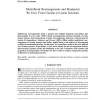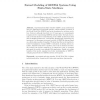638 search results - page 62 / 128 » Taming architectural evolution |
ICSE
2000
IEEE-ACM
13 years 11 months ago
2000
IEEE-ACM
This paper, in the first chapter summarizes the state of the art in SCM, showing the evolution along the last 25 years. Chapter 2 shows the current issues and current research wor...
COGSCI
2007
13 years 7 months ago
2007
: Modularity in the human brain remains a controversial issue, with disagreement over the nature of the modules that exist, and why, when and how they emerge. It is a natural assum...
JCB
2008
13 years 7 months ago
2008
Multi-break rearrangements break a genome into multiple fragments and further glue them together in a new order. While 2-break rearrangements represent standard reversals, fusions...
ISVLSI
2008
IEEE
14 years 2 months ago
2008
IEEE
The evolution of deep submicron technologies allows the development of increasingly complex Systems on a Chip (SoC). However, this evolution is rendering less viable some well-est...
ICWE
2011
Springer
12 years 11 months ago
2011
Springer
Representational State Transfer (REST), as an architectural style for distributed hypermedia systems, enables scalable operation of the World Wide Web (WWW) and is the foundation f...




